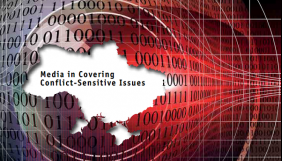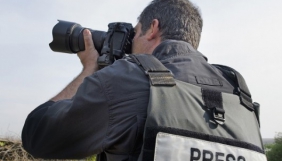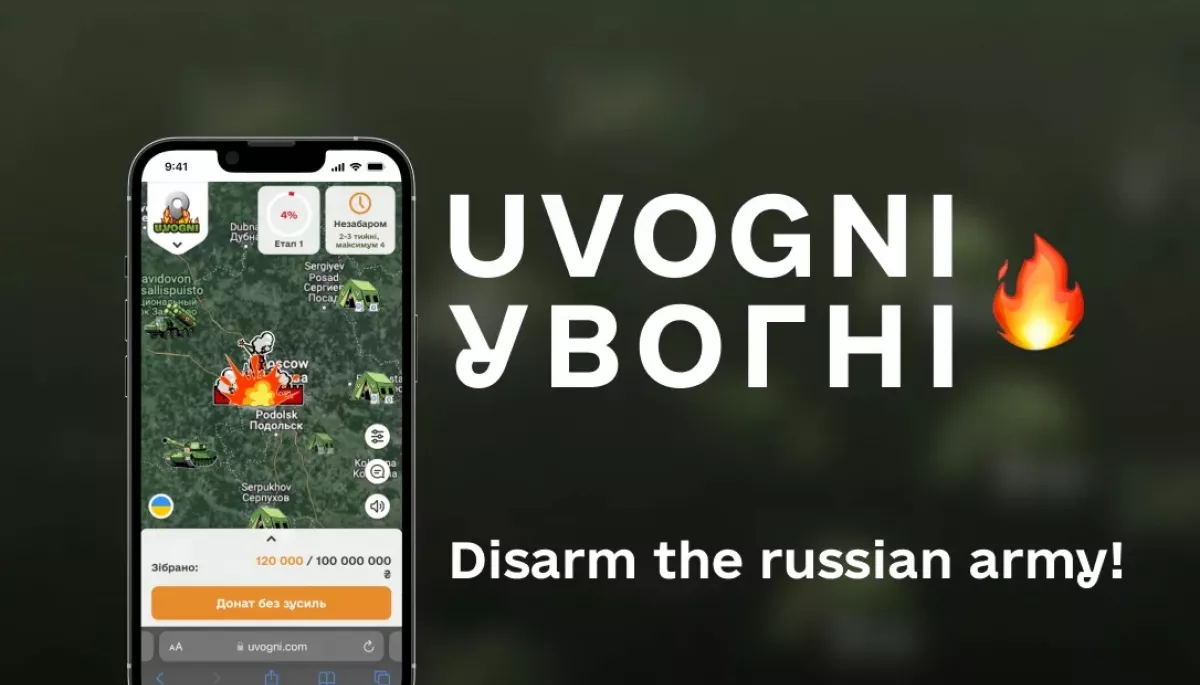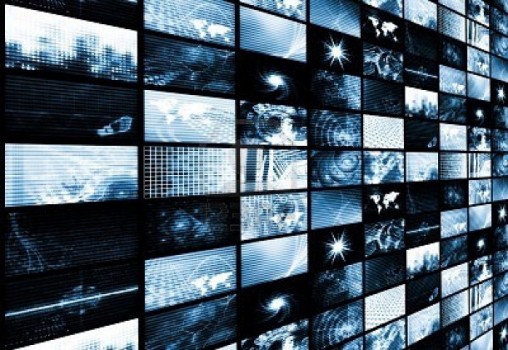
Monitoring results of the conflict-sensitive coverage of groups involved in the conflict by central and regional TV-channels
Виділіть її та натисніть Ctrl + Enter —
ми виправимo
Monitoring results of the conflict-sensitive coverage of groups involved in the conflict by central and regional TV-channels
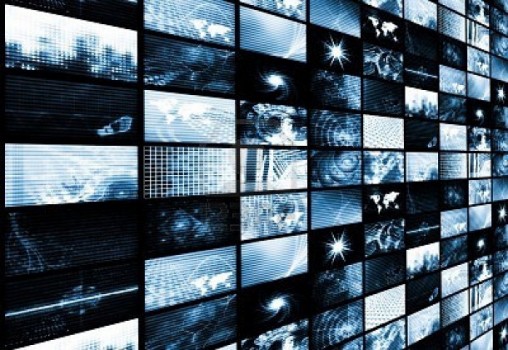

In Ukrainian
These are the monitoring results of the conflict-sensitive coverage of groups involved in the conflict by Ukrainian TV-channels; the monitoring was performed by Telekritika NGO within the OSCE’s project funded by the UK Embassy to Ukraine.
From 6 November till 6 December 2015 the Telekritika NGO expert team was monitoring the news and talk shows of Ukrainian TV-channels (20 regional and 7 central ones) in terms of coverage of different social groups involved in the conflict. The monitoring was to identify if the media discourse favours the social dialogue, if it is able to destroy the conflict paradigm in minds or contrariwise builds new barriers in the society and escalates internal tensions caused by the conflict.
The monitoring discovered the following trends in the Ukrainian TV-media:
- The Ukrainian channels are not agents for conflict alleviation in the society. Leaning to the BW world-view, practicing of hate speech against the other party of the conflict (against Russia’s citizens as well), concealing of problems of conflict-affected social groups do not contribute to the dialogue and reconciliation.
- The discourse of central channels’ social talk-shows is much more aggressive than the one of the news, and it may be a powerful trigger of hostility between different conflict-affected groups as well as of other social and latent conflicts.
- TV-channels talk a lot about ATO fighters: they are mentioned in 12% of stories on central TV-channels (10% on the regional ones). But in 27% cases (13% for regional channels) such mentions are not neutral. The journalists tend to glorify the fighters (‘heroes’, ‘best sons of Ukraine’), to identify them as ‘Ukrainians’ (as opposed to the other party), recognize themselves on the same side of the fence (‘our guys’). The fighter’s topic is actively exploited by central channels’ talk-shows causing the audience to feel pride, respect or sympathy.
- The other party of the conflict is mentioned in 11% of coverages by central channels and 3% by regional ones, and the share of conflict-insensitive messages is the highest among the considered groups (64% and 39% respectively). The other party is described as ‘bandits’, ‘terrorists’, and this makes clear distinction between ‘us’ and ‘them’, ‘good’ and ‘bad’. There were detected cases of cultivation of hatred and other negative emotions against the other party by central channels’ talk-shows.
- The displaced persons are ignored by central channels – only 1% of news pieces have mentions about them. Talk-shows ignore them as well. Regional channels pay more attention to the displaced persons – 3% of messages. Journalists try to focus on positive aspects of ‘new life’ but the regional news show the cases of negative stereotypes spreading: displaced persons as isolated and passive group having chronical problems with integration to new community (12% of identified stories are about this social group).
- The residents of occupied areas are hardly mentioned both by central (4%, and the majority of them are about ‘grey area’) and regional (1%) channels. Real problems and needs of these people do not get to the media discourse. The coverages are neutral mostly, it is hard to tell clear trends given the isolated violations (‘zombified population’, 1+1). The aggressive hate speech against this group is practiced by central channels’ talk-shows (in particular, ‘War and Peace’ and ‘LifeCode’).
- The topic of volunteers is ignored by central channels – both in news (2% of stories) and talk-shows. Regional channels cover the topic correctly (it is mentioned in 4% of news stories), there are isolated instances of negative stereotypes spreading (volunteers as an isolated group of people of questionable quality).
- Families of militaries and children are not properly covered by the media. Each of these groups is mentioned only in 1% of central channels’ news and 2% of regional ones. Though all of these stories are conflict sensitive; only one story had signs of negative stereotypes spreading (being 6% of all detected mentions of militaries’ families in regional news). The talk-shows were noticed with an instance of emotional and unbalanced coverage of problems of militaries’ families (coverage of the facts of discrimination and ostracism against a family of serviceman by talk-show ‘Wayfarers’ (Podorozhni), 9 November).
- The very journalists are a conflict source in the news pieces in 69%, and in 31% this are people on camera. Given this, it is fair to say that the journalists in conflict are rather triggers of conflict discourse than passive transmitters.
- The central channels’ talk-shows are more likely to strengthen than to clear the barriers and hatred. In addition to promotion of the mentioned ‘us’ and ‘them’ distinction (glorification of Ukrainian soldiers and demonization of the other party), some talk-shows foster negative attitude to the occupied area residents (‘War and Peace’, 1 December), justify violence (‘Wayfarers’ (Podorozhni), 17 November), focus on inter-regional differences (‘War and Peace’, 17 November), stoke the ethnic and religious tensions (‘LifeCode’, 20 November).
For more detailed monitoring reports (in Ukrainian) please visit:
Monitoring of central channels’ news
Monitoring of regional channels’ news
Monitoring of central channels’ talk-shows
Methodology
The monitoring of conflict-sensitive coverage of problems of social groups involved in the conflict by Ukrainian TV-channels is performed by Telekritika NGO within the project implemented by the OSCE Project Co-ordinator in Ukraine with the financial support by the UK Embassy to Ukraine.
Subjects of monitoring:
- Evening news of Ukrainian central TV-channels (1 + 1, Inter, STB, Novy, UA:Pershyi, Ukraine, Channel 5) during 1 week (16-22 November)
- Evening news of 20 TV-channels in 10 Ukrainian regions for during 1 week (16-22 November): "Dnipropetrovskyi Derzhavnyi" (Dnipropetrovsk), "Tisa" (Uzhgorod), "Avers" (Lutsk), "Scythia" (Kherson), "Nova Volyn" (Lutsk), "VTV Plus" (Kherson), Channel 34 (Dnipropetrovsk), "Vintera" (Vinnytsia), Zaporizhia RSTBC, "Ltava" (Poltava), ATN (Kharkiv), Odessa RSTBC, OTB (Kharkiv), TVA (Chernivtsi), "Vita" (Vinnytsa), TV5 (Zaporizhia), Channel 21 (Uzhgorod), "Pervyi Gorodskoy" (Odessa), "Bukovyna" (Chernivtsi), "IRT-Poltava".
- Social talk-shows of central TV-channels of Ukraine from 6 November 6 till 6 December 2015: "Wayfarers” (Podorozhni) (UA Pershyi); “War and Peace’ (UA Pershyi) "LifeCode» (ZiK); "Affects Everyone" (Inter); "Govoryt Ukraina" (Ukraine); "Bravehearts" (2+2); "One for All" (STB).
The monitoring was to define how Ukrainian media cover problems of the groups involved in the Ukrainian conflict, these are: ATO fighters, displaced persons, the other party of conflict (both the insurgents and the RF Government), occupied area residents, volunteers, families of Ukrainian servicemen as well as children affected by the conflict. The monitoring was focused on the following aspects: i) representation of target groups on media scene; ii) observance of journalism standards when covering the mentioned groups; iii) conflict sensitivity of communications.
More details about the methodology (in Ukrainian) here.



